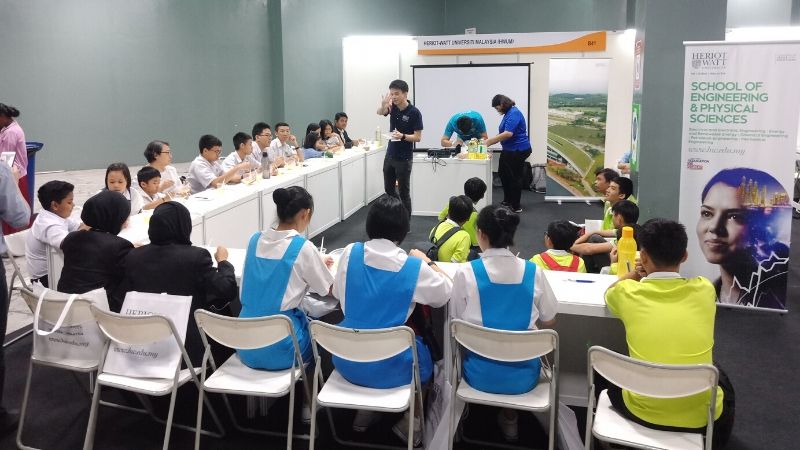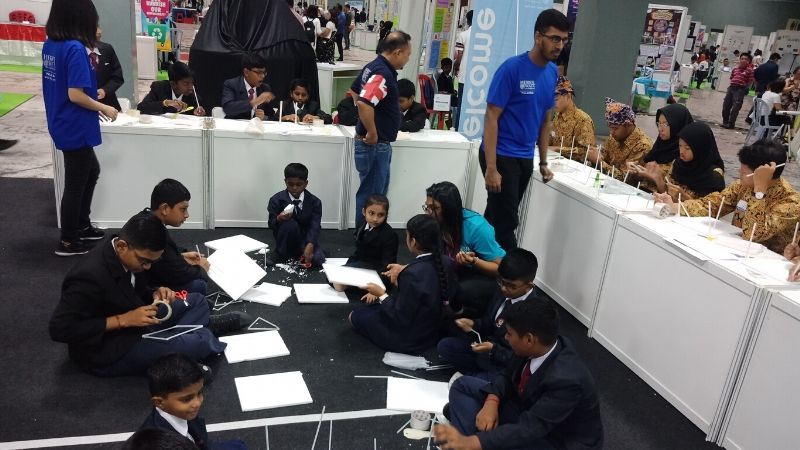Published:

Over 60,000 people visited the 6th Kuala Lumpur Engineering and Science Fair (KLESF) over 3 days from 1 to 3 November 2019. Here, the primary and secondary school students competed in various challenges related to Science, Technology, Engineering and Mathematics (STEM) subjects. Heriot-Watt University Malaysia (HWUM) ran several workshops (#WattShops) there since three years ago to help elevate the declining interest in STEM among the high school students. These #WattShops were:
1. ChemE Kitchen (Ng Lik Yin)
Chemical Engineering principles could be found everywhere, even in the kitchen. Most people knew that oil and water could not be mixed under a normal condition as they tend to separate out from each other. In order to produce a mixture of two immiscible liquids, an emulsifier was used. This concept was demonstrated in a mayonnaise-making workshop in which all participants enjoyed tuna sandwiches dressed with the mayonnaise they made.
2. Bow and Arrow (Vinod Kumar Venkiteswaran and Noor Shieela Kalib)
Mechanical Engineers built machines with accuracy and precision in mind. This concept was demonstrated in the construction of a working bow and arrow set from pencils, rubber bands, masking tapes and bamboo sticks. The participants used their bow and arrow sets to hit a target about 3 metres away. They were given 3 chances each to reveal whether they were sharp-shooters who managed to hit the bull's eye (accurate) or another spot consistently (precise) or otherwise (not accurate nor precise).
3. Frictionless Wheel (Yew Weng Kean)
In practice, magnetic levitation trains with static magnets were constructed using electromagnetism concept. This concept could be demonstrated by floating a set of 2 wheels and an axle above a set of 4 magnets. At the end of the workshop, a mini competition was conducted to test how long the prototypes could rotate in a frictionless environment.
4. Floating Rig (Zaimul Khalik Md Mustaffa)
Offshore drilling deeper than 500 metres required an operation from a floating vessel as fixed structures were not practical. This floating vessel (rig), a semi-submersible, obtained most of its buoyancy from ballasted or watertight pontoons located below the ocean surface and wave action. Participants were required to design the highest but the most stable rigs that could withstand fierce wind and strong wave using materials provided.
5. Colourful Engineering (Lee Xia Sheng)
This workshop introduced participants to the function of Augmented Reality (AR) in various disciplines of engineering. Participants were asked to colour several pre-printed papers containing various shapes of objects with crayons. At the end of the workshop, the participants presented their artwork using AR with the help of portable devices like tablets and smartphones.
The HWUM team led by Dr. Nooryusmiza Yusoff consisted of 6 engineering lecturers and 11 students from EPS, EGIS and MACS. All of the #WattShops were well-received with some participants had to sit on the carpeted floor to complete their tasks.
Gallery
